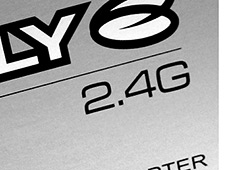Why Choose a 2.4G RC Helicopter or Drone?

What is 2.4G?
Recent developments have provided a new and more secure frequency - 2.4GHz - for use with radio controlled models. Basically, 2.4G technology allows the transmitter and receiver to be 'locked-on' to the same frequency ensuring much improved reliability and peace of mind when flying.
Is 2.4GHz a better option than 35Mhz?
The advantages of 2.4GHz systems are explained in the information below.
Improved reliability
Operating at 2.4 Gigahertz puts the radio control out of the frequency range of any 'noise' caused by the other electronic components on your helicopter - such as the motor, speed controller and any metal to metal noise - eliminating interference and glitching that can affect a 35 megahertz system.
Improved performance
The high data rate of 2.4 GHz systems offers quicker, more responsive control, when compared to a standard 35 MHz system.
Safety and security
Obviously, the last thing you need when piloting an RC helicopter is anything that might cause loss of control or a crash. In urban areas you may not be aware if your neighbour is also flying on the same frequency as you. The built-in security of the 2.4G system allows you to maintain radio control at all times, ensuring your safety and that of others around you.
Lower power consumption
Within the same control range (up to 250m), a 2.4G system will consume only a fraction of the power required by a 35mhz system - about 4mW compared to 750mW - saving £s on AA batteries - and allowing you to fly longer!
Club flying
The main characteristic of 2.4G equipment from a RC model
club’s point of view is that no frequency control is
needed. Eliminating the need to check everyone else's channel numbers, prior to flying. No more worries about turning up at a club with the wrong crystal in your Tx.
Council By-laws
With the growth in the popularity of remote control models there comes an inevitable increase in 35mhz frequency conflicts. Councils are already introducing restrictions on where you can use model helicopters on park and municipal land. There are reports that in some areas flying will only be allowed if the RC models are equipped with 2.4Ghz systems.
2.4G Spread Spectrum Technology - how does it work?
Instead of transmitting on one channel at a time, both the transmitter and receiver are constantly hopping from channel to channel - at over 1000 times a second! When you initialy 'pair' your transmitter to your receiver, they initiate the synchronised sequence of channel hopping.
With 2.4GHz effectively 40 channels are available and the sets automatically set themselves to an unused frequency when switched on. Operation is constantly self monitored and the set will move to an unused frequency if any interference is detected.
Any other benefits?
Because 2.4G RC systems work on higher frequency short wave length, the transmitter antenna is only about 15cm long and flexible - avoiding bends and breakages that can occur with traditional 35Mhz telescopic aerials! The receiver antenna is much shorter too - allowing for much neater installation of the radio gear in the helicopter.
Any downsides?
The only downside may be that you won't be able to blame that crash on a radio glitch anymore!
Share this page
All content copyright © BuzzFlyer. No part of this guide's text or images may be copied or reproduced in any form.